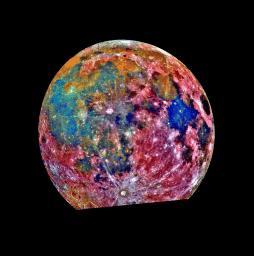 The false-color photograph of the Moon, at left, is a composite of 15 images of the Moon taken through three color filters by the Galileo spacecraft's solid- state imaging system on December 8, 1992, as the deep space probe was just 262,000 miles from the Moon and 43,000 miles from Earth.
The false-color photograph of the Moon, at left, is a composite of 15 images of the Moon taken through three color filters by the Galileo spacecraft's solid- state imaging system on December 8, 1992, as the deep space probe was just 262,000 miles from the Moon and 43,000 miles from Earth.
The false colors help researchers at NASA JPL interpret the composition of the Moon's surface soil. Red areas are lunar highlands, while shades of blue and orange are the ancient volcanic lava flow of a mare, or lunar sea Bluer mare areas contain more titanium than do the orange regions. For instance, the deep blue patch on the right, Mare Tranquillitatis, is richer in titanium than Mare Serenitatis, which is the slightly smaller circular area immediately adjacent to the upper left of Mare Tranquillitatis. The blue and orange areas covering much of the left side of the Moon represent many separate lava flows in Oceanus Procellarum. The small purple areas near the center are pyroclastic deposits formed by explosive volcanic eruptions. The fresh crater Tycho, with a diameter of 53 miles, is prominent at the bottom of the photograph, where part of the Moon's disk is missing. |